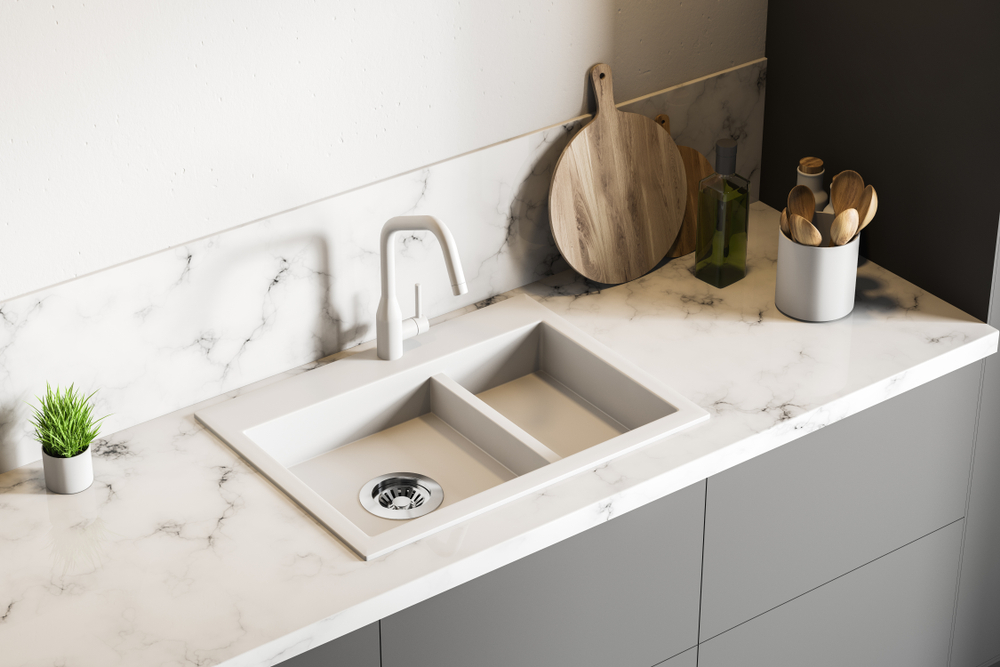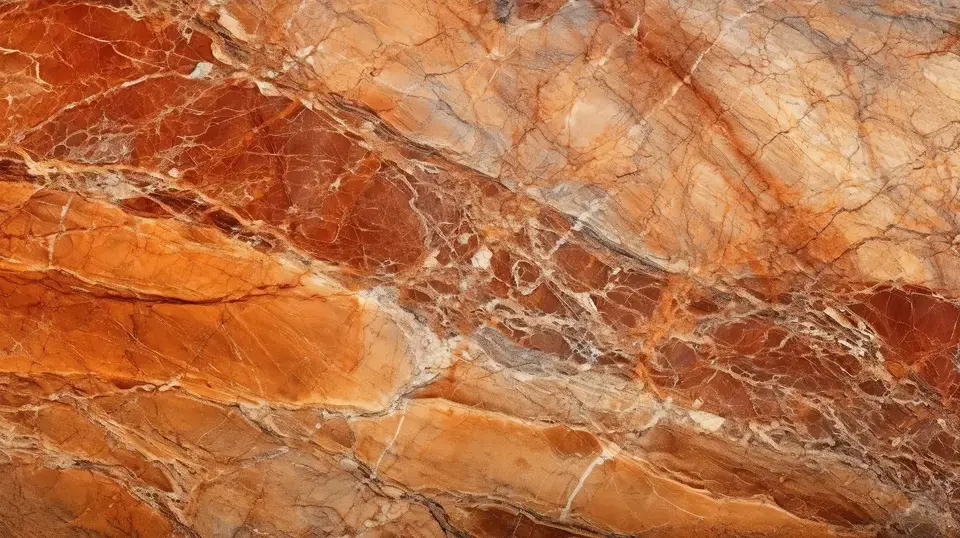Honed vs polished marble presents a fascinating choice. A luxurious shine or a sophisticated matte finish, each offering unique benefits for your design.
Honed marble, characterized by its matte, smooth surface, boasts a refined elegance that exudes understated sophistication. Conversely, polished marble dazzles with its glossy, mirror-like sheen, radiating a sense of luxury and grandeur.
Honed Marble Floors

Honed marble is a type of marble that has been polished to a smooth, flat, matte finish. Unlike polished marble, which has a glossy surface, honed marble has a more subdued appearance with a satin-like finish.
It retains the natural color and veining of the marble but lacks the reflective properties of polished marble. Honed marble is typically less prone to showing scratches and etching compared to polished marble, making it a popular choice for flooring.
Visually, honed marble floors have a soft, velvety appearance due to their matte finish. They lack the high shine of polished marble and instead offer a more understated elegance.
The texture of honed marble is smooth to the touch but not as slippery as polished marble, making it a suitable option for flooring in areas where slip-resistance is important.
There are several advantages to choosing honed marble for flooring:
Subdued Elegance: Honed marble offers a sophisticated aesthetic without the high gloss of polished marble, making it suitable for both traditional and contemporary interior designs.
Conceals Imperfections: The matte finish of honed marble helps to conceal minor scratches, etching, and wear and tear, making it a practical choice for high-traffic areas.
Less Maintenance: Honed marble typically requires less maintenance than polished marble since it doesn’t show water spots or fingerprints as readily. Routine cleaning and periodic resealing are usually sufficient to keep honed marble floors looking their best.
Versatility: Honed marble comes in a variety of colors and patterns, allowing for flexibility in design choices. It can go well with many different interior design motifs and colour palettes.
Natural Beauty: Like all types of marble, honed marble offers unique veining and variations in color, adding natural beauty and character to any space.
When it comes to maintenance and care of honed marble floors, there are several considerations to keep in mind:
Regular Cleaning: Sweep or vacuum the floors regularly to remove dirt and debris. Use a pH-neutral cleaner and a soft mop or cloth to clean the surface. Avoid harsh or abrasive cleaners, as they can damage the finish of the marble.
Sealing: Honed marble should be sealed regularly to protect it from staining and moisture penetration. The frequency of marble sealing will depend on factors such as the type of marble and the level of use, but as a general rule, resealing every 6 to 12 months is recommended.
Avoid Acidic Substances: Acidic substances like citrus juice, vinegar, and certain cleaning products can etch the surface of honed marble. Wipe up spills promptly and avoid using acidic cleaners on the floors.
Protective Measures: Use felt pads or coasters under furniture legs to prevent scratching the marble surface. Place mats or area rugs in high-traffic areas to reduce wear and tear.
Professional Maintenance: Periodically have the floors professionally cleaned and resealed to maintain their appearance and durability.
Exploring Polished Marble Floors
Polished Marble:
Polished marble refers to marble that has undergone a process of grinding, honing, and polishing to achieve a smooth, glossy surface. It is a type of metamorphic rock primarily composed of crystallized limestone, with various mineral impurities giving it its distinct colors and veining patterns. The polishing process enhances the natural beauty of marble, creating a luxurious and elegant finish.
Visual Appearance and Texture:
Polished marble floors exhibit a high gloss, reflective surface that adds a sense of sophistication and opulence to any space. The natural veining and patterns within the marble are accentuated by the polishing process, creating unique and visually striking designs. In terms of texture, polished marble has a smooth and sleek feel underfoot, making it pleasant to walk on.
Advantages of Choosing Polished Marble Flooring:
Aesthetic Appeal: Polished marble floors exude elegance and luxury, enhancing the visual appeal of any interior space.
Durability: Despite its smooth appearance, polished marble is surprisingly durable and can withstand heavy foot traffic without losing its luster.
Variety: Marble comes in a wide range of colors and patterns, allowing for customization to suit different design preferences and architectural styles.
Heat Resistance: Marble naturally stays cool, making it an excellent choice for flooring in warmer climates or areas with underfloor heating systems.
Increase Property Value: The timeless beauty and perceived luxury of polished marble can increase the resale value of a property.
Maintenance and Care:
Regular Cleaning: Dust and dirt can dull the shine of polished marble, so it’s essential to sweep or vacuum regularly to remove debris.
Mild Cleaning Solutions: Use a pH-neutral cleaner specifically designed for marble to clean the floors. Avoid acidic or abrasive cleaners, as they can damage the surface.
Sealing: Apply a penetrating sealer to the polished marble periodically to protect it from stains and moisture infiltration.
Preventive Measures: Place mats at entryways to prevent dirt and grit from being tracked onto the marble floors, and use furniture pads to protect against scratches and dents.
Professional Maintenance: Periodically, have the floors professionally polished and resealed to maintain their shine and integrity.
Honed vs Polished Marble Floors Key Differences

Aesthetic Differences:
Honed Finish: Honed marble has a matte or satin-like appearance with a smooth texture. It lacks the high gloss of polished marble, offering a more natural and understated look. The finish tends to be less reflective and can showcase the stone’s natural color and veining more prominently.
Polished Finish: Polished marble, on the other hand, has a glossy, reflective surface that enhances the stone’s color and veining. It gives off a luxurious and elegant appearance, with a high level of shine that can brighten up a space.
Durability and Performance:
Honed Finish: Honed marble is less prone to showing scratches, etches, and water spots compared to polished marble due to its matte surface. However, it may require more frequent sealing to protect against stains and moisture penetration.
Polished Finish: Polished marble is more susceptible to scratches and etching because of its shiny surface. It’s also more prone to showing water spots and fingerprints. However, polished marble can be easier to clean and maintain due to its smoother surface.
Suitability for Different Design Styles and Preferences:
Honed Finish: Honed marble is often favored in contemporary or rustic design styles where a more subdued and natural appearance is desired. It can complement a variety of design elements without overpowering the space.
Polished Finish: Polished marble is commonly used in traditional or formal settings where a luxurious and refined look is preferred. It adds a sense of grandeur and sophistication to the space.
Cost Comparison and Budget Considerations:
Honed Finish: Generally, honed marble tends to be slightly less expensive than polished marble. This is because the honing process requires less time and labor compared to achieving a high-polished finish.
Polished Finish: Polished marble is often more expensive due to the additional steps involved in polishing the stone to a high shine. Additionally, the maintenance costs, such as regular polishing and sealing, should be factored into the long-term budget.
Factors to Consider When Choosing Between Honed and Polished Marble
When choosing between honed and polished marble, several factors come into play:
Personal preferences and design goals:
Consider the overall aesthetic you want to achieve in your space. Honed marble offers a matte finish, which can impart a more relaxed or rustic look, while polished marble provides a glossy surface that enhances the stone’s natural colors and veining. Your personal style and the design theme of your space will heavily influence this decision.
Practical considerations such as traffic and usage:
Evaluate the level of foot traffic and usage the marble surface will endure. Polished marble tends to be more susceptible to scratching and etching from acidic substances, making it less suitable for high-traffic areas or spaces prone to spills and stains.
Honed marble, with its matte surface, can better hide wear and tear over time, making it a practical choice for busy areas like kitchens and bathrooms.
Maintenance requirements and long-term upkeep:
Think about the maintenance efforts required to keep your marble looking its best. Polished marble typically requires more frequent cleaning and sealing to maintain its shine and protect it from damage.
Honed marble, on the other hand, may be easier to maintain as it shows fewer fingerprints and water spots and may not require as much sealing. Consider your willingness to invest time and effort into regular maintenance when making your decision.
Professional recommendations and expert advice:
Consulting with professionals such as interior designers, architects, or stone specialists can provide valuable insights into the pros and cons of each option based on your specific needs and circumstances.
They can offer guidance on selecting the most suitable finish for your project based on factors like durability, aesthetics, and budget.
Conclusion
Honed and polished marble floors present distinct characteristics that cater to different preferences and needs. Honed marble offers a matte finish with a smoother texture, making it less prone to showing scratches and etching.
This makes it an ideal choice for high-traffic areas or spaces where a more natural, understated look is desired. On the other hand, polished marble boasts a glossy surface that reflects light, enhancing the stone’s natural veining and colors.
While it may require more maintenance to preserve its shine and is more susceptible to scratches and etching, polished marble exudes a luxurious and elegant aesthetic, perfect for formal settings or those seeking a statement flooring option. Feel free to contact us for any type of query or services related to honed vs polished marble.
FAQs
What Is The Main Difference Between Honed And Polished Marble?
The main difference lies in the finish. Honed marble has a matte, smooth surface, while polished marble has a glossy, reflective finish.
Which Is More Resistant To Scratches And Etching, Honed Or Polished Marble?
Honed marble is generally more resistant to scratches and etching due to its matte finish, which makes imperfections less noticeable compared to polished marble.
Which Type Of Marble Is Easier To Maintain?
Honed marble tends to be easier to maintain as it doesn’t require as much upkeep to preserve its appearance compared to polished marble, which may need regular polishing to maintain its shine.
Which Is Better For High-Traffic Areas, Honed Or Polished Marble?
Honed marble is often recommended for high-traffic areas as it is less likely to show wear and tear, thanks to its matte surface that can camouflage scratches and scuffs.
Which Type Of Marble Is More Suitable For Formal Or Luxurious Spaces?
Polished marble is typically favored for formal or luxurious spaces due to its glossy finish, which enhances the stone’s natural beauty and creates an elegant aesthetic.
Can Honed And Polished Marble Be Used Interchangeably In Any Space?
While both types of marble can be used in various settings, the choice depends on the desired aesthetic, level of maintenance, and the specific requirements of the space. Consider factors such as lighting, foot traffic, and overall design goals when selecting between honed and polished marble.





